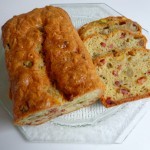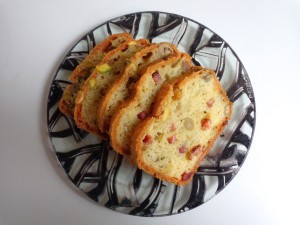Savory cake with olives, bacon and pistachios
This rich and savory cake is perfect for a special cocktail hour. It marries well with kir, white wine, red wine, champagne, apéritif wines like vermouth or sherry — or stronger spirits. One cake will serve 10 people, and if you need less than a whole cake the remainder can be frozen and used on another occasion.
Be prepared to spend a little more time in the kitchen than usual. The preparation phase takes about an hour, and involves peeling the pistachios — not as difficult as it sounds, although it does take time. Then add on another hour for baking.
You will need a 1-1/2-quart (liter) bread pan.
1-1/2 cups (250 g) flour, plus a little extra
1 tbsp. plus 1 tsp. (1 packet) baking powder
2/3 cup (60 g) shelled pistachios
5 ounces (150 g) pitted green olives
7 ounces (200 g) thick-cut bacon
6 ounces (175 g) comté, gruyère or a similar cheese
4 eggs
1 cup (20 cl) olive oil
1/2 cup (10 cl) dry white wine
freshly ground black pepper
Measure 1-1/2 cups (250 g) flour into a large bowl. Add the baking powder. Set aside.
You next need to remove the peel from the pistachios. Bring a little water to a boil in a saucepan. Add the pistachios and cook for 1 minute. Drain. When cool enough to handle, slip off the peels. Place the peeled pistachios in a small bowl. Set aside.
Drain the olives thoroughly, place in a small bowl and set aside.
Chop the bacon into lardons — thick crosswise sticks. Ideally these should measure about 1-1/2 inch long by 1/3 inch wide on both sides (4 cm by 1 cm). Fry in a little olive oil until they are golden but not well done. Drain, place in a small bowl and set aside.
Grate the cheese, using the fine side of the grater. You should finish with about 3 cups of grated cheese, loosely packed. Place in a bowl and set aside.
Now comes a mysterious step that I have been told is absolutely necessary to keep the ingredients from sinking to the bottom of the cake: Sprinkle the pistachios, olives and bacon with a little flour — enough to coat them lightly.
Grease a 1-1/2 quart (liter) bread pan lightly with butter. Add 1 tbsp. flour and shake it around to coat the pan. Holding the pan over the sink, give it a couple of sharp raps to knock out the excess flour.
Preheat the oven to gas mark 6 (350 F, 180 C).
Crack four eggs into the large bowl with the flour. Add the olive oil and white wine. Beat with an electric beater until thoroughly blended and smooth.
Add the olives, bacon, pistachios and grated cheese to the batter. Stir in with a wooden spoon until thoroughly blended. Grind in some black pepper and stir again.
Turn the batter into your greased bread pan. Place in the oven.
 Bake for 20 minutes, then open the oven and cover the loaf loosely with a sheet of aluminum foil (to keep the top from browning too much). Bake for another 40 minutes, or until the loaf is golden and a toothpick inserted comes out clean.
Bake for 20 minutes, then open the oven and cover the loaf loosely with a sheet of aluminum foil (to keep the top from browning too much). Bake for another 40 minutes, or until the loaf is golden and a toothpick inserted comes out clean.
Allow to cool for easier slicing. This cake may be eaten cold, but it is best served when warm. If you prepare the cake in advance, you can slice it while cool, wrap the slices in aluminum foil and reheat in a medium oven for 5-10 minutes before serving. Serves 10.






To avoid any confusion, it would be useful to add a volume-to-weight coversion table to the Basics section. In the above recipe, 1 cup of flour equals to 167 grams. However, the calculation based on USDA database showed that the weight of 1 US cup (240 ml) of the all-purpose wheat flour was 125 g, i.e. 25% less. Is it because of different quality (density) of flour used in France?
Best regards,
Jaroslav
Hello Jaroslav and thanks for the suggestion. Great idea! I will try to get a conversion chart into the Basics section very soon. As for the above cake recipe, however, I can assure you that I weighed the flour before measuring it — the original recipe, given to me by a French friend, was in grams — and only then measured it into an American cup. The conversion is thus accurate. I don’t know whether there is a difference in density between French and American flour. What I do know it that cooking is closer to alchemy than to chemistry. Maybe trust the recipe, in whichever format you choose (grams or cups), and if it doesn’t work out well, then please let me know. All best, Meg
Hello Meg,
Using the weight units, I made a few batches of the cake and they were all excellent! Here are several remarks:
– coating the solid ingredients with flour worked well except for olives which floated slightly upwards, presumably due to the cavities in them. Cutting the olives longitudinally eliminated this problem
– adding a little salt improved palatability
– using the peeled chestnuts cut into quarters instead of pistachios gave comparable, if not better results.
Best regards, Jaroslav
Jaroslav, many thanks for the tips — and I’m so glad the cake turned out well in all its guises!